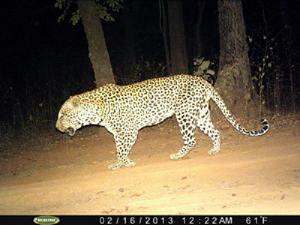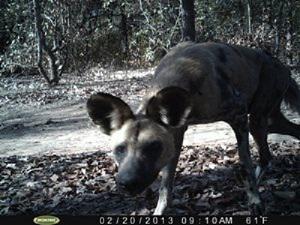Mamadou Daha Kane
The goal of this study is to estimate distribution and abundance of the Niokolo Koba National Park large carnivores by conducting surveys using camera trapping and scat collection methods.

Objective 1: Camera trapping: Given that the study area covers 9,130 km2, I will sample two smaller areas within the park setting up a grid of camera stations. I will use data from the pilot study and input from park officials to determine locations of each camera grid. Each camera grid will consist of 30 camera stations – with two cameras at each station mounted in opposing sides of roads and trails to capture both sides of target species to allow identification of individuals that have unique coat patterns. I will use digital and film remotely triggered cameras (Moultrie D-55, DeerCam 200/300) with a spacing of ~3km between stations. Cameras will operate for 75 days at each of the two locations to provide adequate sample sizes for parameter estimation. Population density will be estimated (using mark-recapture models in program MARK) for individually identifiable carnivores: leopards, African wild dogs, spotted hyenas and any other individually identifiable small cat and canid species.

Objective 2: Scat collection: Scat (fecal) samples will be collected within both camera grids. I will search opportunistically for scats using preexisting roads and trails. I will train a team of experienced rangers – in identifying carnivore feces for collection. Scats will be cleared out after being sampled and each of the two camera grids will be sampled four times over the duration of the two months survey. Species and individuals will be identified through genetic analyses and their abundances and densities estimated using traditional capture-recapture methods and through newer spatially explicit capture-recapture analyses through programs MARK, DENSITY and/or SPACECAP. These will be compared to those computed from the camera-traps and efficiency of each technique will be evaluated.

Objective 3: Habitat analysis: It is important for species conservation to determine whether carnivore species of interest select specific types of vegetation. To document habitat preferences, I will conduct microhabitat sampling at each camera location within variable radius buffers (depending on species) surrounding each camera station. In each sampled area, I will classify the canopy cover and note the dominant vegetation species. Then I will classify the habitat features in the seven main vegetation classes of the park. In addition I will extract macro-habitat features from a GIS database (e.g. distance to water and park edge, road density, etc.) to use in habitat modeling. This information will allow me to map habitat preferences for each species to determine the relationships among them. Coupled with the presence and trapping rates of herbivore species detected by cameras, these data will provide information regarding the importance of habitat versus prey species and/or other competitors. I plan to use regression techniques and AIC model selection to determine the importance of habitat versus other species in determining presence and trapping rates of each target carnivore.